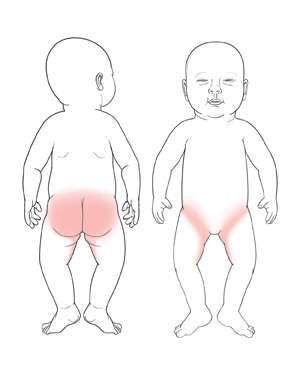Diaper Rash, Noninfected (Infant/Toddler)
 |
| Areas where diaper rash can form. |
Diaper rash is a common skin problem in infants and toddlers. The rash is often red with small bumps or scales. It can spread quickly. The rash can appear in the skin folds of the upper and inner legs, the genitals, and the buttocks.
Diaper rash is often caused by urine and feces, especially if diapers aren't changed often. When urine and feces combine, they make ammonia. Ammonia is a chemical that irritates the skin. Young children’s skin can also be irritated by baby wipes, laundry detergent and softeners, and chemicals in diapers.
The best treatment for diaper rash is to change a wet or soiled diaper as soon as possible. The soiled skin should be gently cleaned with warm water. After the skin air-dries, put a barrier cream or ointment, like zinc oxide, on the rash. In most cases, the rash will clear in a few days. If the rash is untreated, the skin can develop a yeast or bacterial infection.
Home care
Follow these tips when caring for your child at home:
-
Always wash your hands well with soap and warm water before and after changing your child’s diaper and applying any cream or ointment on their skin.
-
Check for soiled diapers regularly. Change your child’s diaper as soon as you notice it's soiled. Gently pat the area clean with a warm, wet soft cloth. If you use soap, it should be gentle and scent-free.
-
Apply a thick layer of barrier cream or ointment on the rash. The cream can be left on the skin between diaper changes. New layers of cream can be safely applied on top of previous, clean layers. A layer of petroleum jelly can be put on top of the barrier cream. This will prevent the skin from sticking to the diaper.
-
Don’t over-clean the affected skin areas. Also don’t apply powders, such as talc or cornstarch, to the affected skin areas.
-
Change your child’s diaper at least once at night. Put the diaper on loosely.
-
Allow your child to go without a diaper for periods of time. Exposing the skin to air will help it to heal.
-
Use a breathable cover for cloth diapers instead of rubber pants. Slit the elastic legs or cover of a disposable diaper in a few places. This will allow air to reach your child’s skin.
Follow-up care
Follow up with your child’s healthcare provider, or as advised.
When to get medical advice
Unless your child's provider advises otherwise, call them right away if your child:
-
Has a fever (see "Fever and children" below).
-
Is fussier than normal or keeps crying and can't be soothed
-
Has a rash that doesn’t get better or gets worse after several days of treatment
-
Seems uncomfortable or complains of too much itching
-
Has new symptoms, such as blisters, open sores, raw skin, or bleeding
-
Has signs of infection in the affected skin areas (such as warmth, redness, swelling, or abnormal or bad-smelling fluid leaking)
Fever and children
Use a digital thermometer to check your child’s temperature. Don’t use a mercury thermometer. There are different kinds and uses of digital thermometers. They include:
-
Rectal. For children younger than 3 years, a rectal temperature is the most accurate.
-
Forehead (temporal). This works for children age 3 months and older. If a child under 3 months old has signs of illness, this can be used for a first pass. The provider may want to confirm with a rectal temperature.
-
Ear (tympanic). Ear temperatures are accurate after 6 months of age, but not before.
-
Armpit (axillary). This is the least reliable but may be used for a first pass to check a child of any age with signs of illness. The provider may want to confirm with a rectal temperature.
-
Mouth (oral). Don’t use a thermometer in your child’s mouth until they are at least 4 years old.
Use the rectal thermometer with care. Follow the product maker’s directions for correct use. Insert it gently. Label it and make sure it’s not used in the mouth. It may pass on germs from the stool. If you don’t feel OK using a rectal thermometer, ask the healthcare provider what type to use instead. When you talk with any healthcare provider about your child’s fever, tell them which type you used.
Below are guidelines to know if your young child has a fever. Your child’s healthcare provider may give you different numbers for your child. Follow your provider’s specific instructions.
Fever readings for a baby under 3 months old:
-
First, ask your child’s healthcare provider how you should take the temperature.
-
Rectal or forehead: 100.4°F (38°C) or higher
-
Armpit: 99°F (37.2°C) or higher
Fever readings for a child age 3 months to 36 months (3 years):
-
Rectal, forehead, or ear: 102°F (38.9°C) or higher
-
Armpit: 101°F (38.3°C) or higher
Call the healthcare provider in these cases:
-
Repeated temperature of 104°F (40°C) or higher in a child of any age
-
Fever of 100.4° (38°C) or higher in baby younger than 3 months
-
Fever that lasts more than 24 hours in a child under age 2
-
Fever that lasts for 3 days in a child age 2 or older